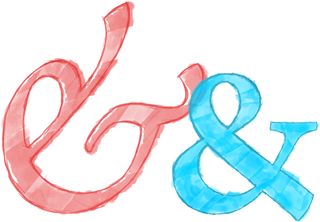Print to Screen, Static to Dynamic

A little over a week ago I attended the first U.S. incarnation of Ampersand, a web-centric gathering of type pros and enthusiasts hosted by the good folks at Clearleft. The days since have been a bit packed, so I’m totally being that guy and just getting around to posting something about it now.
One of the highlights for me was Jonathan Hoefler’s talk on the evolution of web typography, starting with the construction of his own Hoefler Text and leading all the way to the launch of H&FJ’s cloud.typography service. Nuanced and timely, Hoefler conveyed a ton of detail with impressive eloquence. To echo Jeffrey’s tweet, it was one of the best type talks I’ve seen.
Hoefler dissected the problems that come from blindly applying existing methods to new mediums. For web type, that means reusing fonts originally designed for print without tuning them for the screen. It might not seem too bad, but consider that what you see on screen when you’re using a print font is actually a representation of the intended output, not the actual design.
The results can be pretty horrific, even to the untrained eye. But it’s still the way many typefaces make it to the web. Hoefler summarized the situation as having, “fonts on the web, but not fonts for the web,” and went on to detail the incredible effort H&FJ has put into retooling their own type library for the screen.
I do have a little quibble with something that came up later in the talk, though.
At one point Hoefler displayed two maps side by side to illustrate a point about the typographic richness we’ve lost (or have yet to rebuild) in the shift from print to digital. On one side was an old print map, dense with typographic details, all used to convey a wide array of information in a single packed view. On the other side was a relatively sparse screenshot from an online map service, sporting few if any typographic details.
In the context of a static presentation slide, the print map seemed like the one using typography to maximum effect. It conveyed the most information in a single glance. The absence of that detail in the interactive map gave the impression that the newer service had less to offer. But the context is incomplete.
The paper map is a piece of static information design. It needs to convey everything it can in the single view it has. The density of its typography is a feature born of necessity. It can’t adapt to its context, and has no ability to selectively give focus to what’s relevant at the moment.
The digital map can do all these things. It doesn’t need type to function in exactly the same way it did in print because it’s dynamic and adaptable. That doesn’t mean it doesn’t need typographic richness. It just doesn’t have to show it the same way as the print map.
A frozen picture of the thing simply doesn’t convey the fundamental nature of it. It isn’t fully realized until it’s interacted with. And that’s important to remember when making these old-vs-new comparisons.